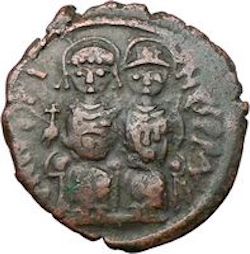
Justin II and Queen Sophia on a coin, c. 565-578 CE.
Remnants of the Byzantine Empire can be found on colorful mosaics and frescoes from the medieval period, and they do little justice to the opulence of the empire that dominated Eastern Europe in the medieval era. Sophia was the daughter of Empress Theodora’s elder sister, Komito, and the military general, Sittas, and was born around 530 C.E. Given her royal heritage, Sophia had a significant position in society, though her status as a woman during the period did limit her political endeavors. Soon she was married to Justin II, whom she directly helped to place on the throne in 565 C.E. following the legendary Emperor Justinian’s rule. From the beginning of his reign, it became obvious that Sophia would not let her status as a woman prevent her from having direct involvement in her husband’s rule.
Sophia’s dedication to her and her husband’s political duty can be seen in the way in which their unity of rule was illustrated on the coins. Both Sophia and Justin were shown on the face of the coin, and this hinted at the fact that they ruled together and had equal amounts of power. This was particularly revolutionary for a woman during the period to have an open hand in the politics of her country. She went beyond what her aunt Theodora was able to accomplish: she was not only influential with her financial policies that helped build Byzantium’s wealth, but she was publicly recognized as an active ruler.
Unfortunately, Justin fell ill in 573 C.E. and became unfit to rule. During his absence from the throne, Sophia took direct charge of the Byzantine Empire and appointed a successor she hoped to be able to influence so she could remain on the throne. She even made him sign an agreement that stated his appointment was conditional on the fact that he would recognize her as the rightful empress and do her no evil. Upon Justin’s death in 578 C.E., Sophia tried to keep control of the empire, and even went so far as to offer a marriage proposal to Tiberius, but he refused. Her hunger to remain in power pushed her to try and depose Tiberius’s rule, which robbed her of her status; she was allowed only a small allowance. Eventually, she passed away in 601 C.E. without the title she clung so fervently to throughout her life. She was a tenacious leader and through her strong rule, Sophia dismantled the perception that she was unfit to rule a country because of her gender. Her legacy lasted well after her death.
